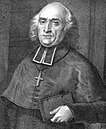Ultra-royalist
Ultra-royalists Ultraroyalistes | |
|---|---|
Roman Catholicism | |
| Chamber of Deputies (1824) | 413 / 430 |
| Part of the Politics series |
| Monarchy |
|---|
 |
|
|
| This article is part of Conservatism in France |
 |
The Ultra-royalists (
The Legitimists, another of the main right-wing factions identified in René Rémond's Les Droites en France, were disparagingly classified with the Ultras after the 1830 July Revolution by the victors, the Orléanists, who deposed the Bourbon dynasty for the more liberal king Louis Philippe.
Second White Terror
Following the return of
Historian
- Throughout the Midi — in Provence, Avignon, Languedoc, and many other places — the White Terror raged with unrelenting ferocity. The royalists found in the willingness of the French to desert the king fresh proof of their theory that the nation was honeycombed with traitors, and used every means to seek out and destroy their enemies. The government was powerless or unwilling to intervene.[12]
Bourbon Restoration
Inaugurating the Bourbon Restoration (1814–1830), a strongly restricted census suffrage elected to the
In 1815, an Ultra majority was elected to the chamber of deputies. Louis XVIII dubbed them La Chambre Introuvable, "the unfindable chamber", due to his astonishment at a group of deputies more royalist than himself. Under the guidance of his chief minister the
The 1824 death of Louis XVIII, whom they saw as too moderate, lifted the spirits of the Ultras: they expected their leader, the new king Charles X, would soon become an absolute monarch, answerable only to God. In January 1825, Villèle's government enacted the
Legitimists, the successor of the Ultras
The 1830 July Revolution replaced the Bourbons with the more liberal Orléanist branch and sent the Ultras back to private life in their country chateaux. However, they retained some influence until at least the
Notable members
-
Prince Charles, Count of Artois
became King Charles X
-
Jean-Baptiste de Villèle
-
Viscount of Chateaubriand
was also very liberal on certain policies (e.g. press) -
Abbé Frayssinous,
royal chapelan and peer -
Casimir-Louis-Victurnien de Rochechouart de Mortemart
-
Édouard de Fitz-James
-
Joseph de Maistre,
chief ideologist -
Viscount of Bonald,
chief ideologist -
Louis XVIII
Electoral results
| Election year | No. of
overall votes |
% of
overall vote |
No. of
overall seats won |
+/– | Position | Leader |
|---|---|---|---|---|---|---|
| Chamber of Deputies | ||||||
| 1815 | 35,200 | 87.5% | 350 / 400
|
New
|
1st (majority) | François-Régis de La Bourdonnaye, |
| 1820 | 34,780 | 36.9% | 160 / 434
|
2nd (minority) | Jean-Baptiste Séraphin, Comte de Villèle | |
| 1824 | 90,240 | 96% | 413 / 430
|
1st (majority) | Jean-Baptiste Séraphin, Comte de Villèle | |
| 1827 | 40,420 | 43.1% | 185 / 430
|
1st (majority) | Jean-Baptiste Séraphin, Comte de Villèle | |
| 1830 | 47,940 | 50.7% | 282 / 556
|
1st (majority) | Jules de Polignac, Duke de Polignac | |
- ^ This change is compared to the last general election which was in August 1815. The elections in 1816, 1817, and 1819 were all by-elections and those results are included
See also
References
- ISBN 9782235021197.
- ISBN 9782213659480.
- ^ Histoire de France, pendant les annees 1825, 1826, 1827 et commencement de 1828, faisant suite a l'Histoire de France par l'abbe de Montgaillard. Vol. 1. 1829. p. 74.
- ^ Treuttel et Würtz, ed. (1844). Encyclopédie des gens du monde: répertoire universel des sciences, des lettres et des arts ; avec des notices sur les principales familles historiques et sur les personnages célèbres, morts et vivans. Vol. 22. p. 364.
- ^ Bailleul, Jacques-Charles (1819). Situation de la France. p. 261.
- ^ Le Normant, ed. (1818). Le Conservateur: le roi, la charte et les honnêtes gens. Vol. 1. p. 348.
- ^ Reboul, Pierre (1973). Presses Univ. Septentrion (ed.). Chateaubriand et le conservateur. p. 288.
- ISBN 9782021094459.)
{{cite book}}: CS1 maint: location missing publisher (link













![Sosthènes de La Rochefoucauld [fr]](http://upload.wikimedia.org/wikipedia/commons/thumb/a/ab/Heim_-_Sosth%C3%A8ne_Ier_de_La_Rochefoucauld_%281785-1864%29.jpg/102px-Heim_-_Sosth%C3%A8ne_Ier_de_La_Rochefoucauld_%281785-1864%29.jpg)





